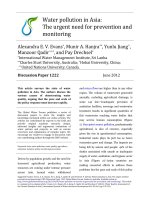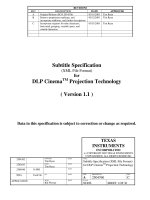The WSIT Tutorial - For Web Services Interoperability Technologies (Version 1.0 FCS)
Bạn đang xem bản rút gọn của tài liệu. Xem và tải ngay bản đầy đủ của tài liệu tại đây (1.46 MB, 238 trang )
The
WSIT
T
utor
ial
For
W
eb
Ser
vices
Inter
operability
T
echnolog
ies
V
e
r
sion
1.0
FCS
September 18, 2007
Copyright © 2007 Sun Microsystems, Inc., 4150 Network Circle, Santa Clara, California 95054, U.S.A.
All rights reserved.U.S. Government Rights - Commercial software. Government users are subject to the
Sun Microsystems, Inc. standard license agreement and applicable provisions of the FAR and its supple-
ments.
This distribution may include materials developed by third parties.
Sun, Sun Microsystems, the Sun logo, Java, J2EE, JavaServer Pages, Enterprise JavaBeans, Java Naming
and Directory Interface, EJB, JSP, J2EE, J2SE and the Java Coffee Cup logo are trademarks or registered
trademarks of Sun Microsystems, Inc. in the U.S. and other countries.
Unless otherwise licensed, software code in all technical materials herein (including articles, FAQs, sam-
ples) is provided under this License.
Products covered by and information contained in this service manual are controlled by U.S. Export Con-
trol laws and may be subject to the export or import laws in other countries. Nuclear, missile, chemical
biological weapons or nuclear maritime end uses or end users, whether direct or indirect, are strictly pro-
hibited. Export or reexport to countries subject to U.S. embargo or to entities
identified
on U.S. export
exclusion lists, including, but not limited to, the denied persons and specially designated nationals lists is
strictly prohibited.
DOCUMENTATION IS PROVIDED "AS IS" AND ALL EXPRESS OR IMPLIED CONDITIONS,
REPRESENTATIONS AND WARRANTIES, INCLUDING ANY IMPLIED WARRANTY OF MER-
CHANTABILITY, FITNESS FOR A PARTICULAR PURPOSE OR NON-INFRINGEMENT, ARE
DISCLAIMED, EXCEPT TO THE EXTENT THAT SUCH DISCLAIMERS ARE HELD TO BE
LEGALLY INVALID.
Copyright © 2007 Sun Microsystems, Inc., 4150 Network Circle, Santa Clara, California 95054, États-
Unis. Tous droits réservés.
Droits du gouvernement américain, utlisateurs gouvernmentaux - logiciel commercial. Les utilisateurs
gouvernmentaux sont soumis au contrat de licence standard de Sun Microsystems, Inc., ainsi qu aux dis-
positions en vigueur de la FAR [ (Federal Acquisition Regulations) et des suppléments à celles-ci.
Cette distribution peut comprendre des composants développés pardes tierces parties.
Sun, Sun Microsystems, le logo Sun, Java, JavaServer Pages, Enterprise JavaBeans, Java Naming and
Directory Interface, EJB, JSP, J2EE, J2SE et le logo Java Coffee Cup sont des marques de fabrique ou des
marques déposées de Sun Microsystems, Inc. aux États-Unis et dans d’autres pays.
A moins qu’autrement autorisé, le code de logiciel en tous les matériaux techniques dans le présent (arti- cles
y compris, FAQs, échantillons) est fourni sous ce permis.
Les produits qui font l’objet de ce manuel d’entretien et les informations qu’il contient sont régis par la
législation américaine en matière de contrôle des exportations et peuvent être soumis au droit d’autres
pays dans le domaine des exportations et importations. Les utilisations
finales,
ou utilisateurs
finaux,
pour
des armes nucléaires, des missiles, des armes biologiques et chimiques ou du nucléaire maritime, directe-
ment ou indirectement, sont strictement interdites. Les exportations ou réexportations vers des pays sous
embargo des États-Unis, ou vers des entités
figurant
sur les listes d’exclusion d’exportation américaines,
y compris, mais de manière non exclusive, la liste de personnes qui font objet d’un ordre de ne pas partic-
iper, d’une façon directe ou indirecte, aux exportations des produits ou des services qui sont régi par la
législation américaine en matière de contrôle des exportations ("U .S. Commerce Department’s Table of
Denial Orders "et la liste de ressortissants
spécifiquement
désignés ("U.S. Treasury Department of Spe-
cially Designated Nationals and Blocked Persons "),, sont rigoureusement interdites.
LA DOCUMENTATION EST FOURNIE "EN L’ÉTAT" ET TOUTES AUTRES CONDITIONS, DEC-
LARATIONS ET GARANTIES EXPRESSES OU TACITES SONT FORMELLEMENT
EXCLUES, DANS LA MESURE AUTORISEE PAR LA LOI APPLICABLE, Y COMPRIS
NOTAMMENT TOUTE GARANTIE IMPLICITE RELATIVE A LA QUALITE MARCHANDE, A
L’APTITUDE A UNE UTILISATION PARTICULIERE OU A L’ABSENCE DE CONTREFAÇON.
Contents
About
This
Tutorial
.
.
.
.
.
.
.
.
.
.
.
.
.
.
.
.
.
.
.
.
.
.
.
.
.
.
.
.
i
x
Who Should Use This Tutorial ix
How to Use This Tutorial
x
About the Examples
x
Typographical Conventions xi
Feedback xi
Chapter
1:
Introduction
.
.
.
.
.
.
.
.
.
.
.
.
.
.
.
.
.
.
.
.
.
.
.
.
.
.
.
.
.
.
.
.
1
What is WSIT? 2
Bootstrapping and Configuration 3
Message Optimization Technology 4
Reliable Messaging Technology 5
Security Technology 6
How WSIT Relates to Windows Communication Foundation (WCF) 6
WSIT
Specifications
7
Bootstrapping and Configuration Specifications 8
Message Optimization Specifications 10
Reliable Messaging Specifications 12
Security Specifications 13
How the WSIT Technologies Work 14
How Message Optimization Works 15
How Reliable Messaging Works 16
How Security Works 18
Chapter
2:
WSIT
Example
Using
a
Web
Container
and
NetBeans23
Registering GlassFish with the IDE 23
Creating a Web Service 24
iii
iv C
ONTENTS
Configuring
WSIT Features in the Web Service 26
Deploying and Testing a Web Service 28
Creating a Client to Consume a WSIT-Enabled Web Service 29
Chapter
3:
Bootstrapping
and
Configuration
.
.
.
.
.
.
.
.
.
.
.
.
.
.
33
What is a Server-Side Endpoint? 33
Creating a Client from WSDL 34
Client From WSDL Examples 35
Chapter
4:
Message
Optimization
.
.
.
.
.
.
.
.
.
.
.
.
.
.
.
.
.
.
.
.
.
.
.
37
Creating a Web Service 38
Configuring
Message Optimization in a Web Service 38
Deploying and Testing a Web Service 39
Creating a Client to Consume a WSIT-enabled Web Service 39
Message Optimization and Secure Conversation 42
Chapter
5: Using
Reliable
Messaging
.
.
.
.
.
.
.
.
.
.
.
.
.
.
.
.
.
.
.
.
43
Reliable Messaging Options 43
Creating Web Service Providers and Clients that use Reliable Messag-
ing 45
Using Secure Conversation With Reliable Messaging 45
Chapter
6: Using
WSIT
Security
.
.
.
.
.
.
.
.
.
.
.
.
.
.
.
.
.
.
.
.
.
.
.
.
.
.
47
Configuring
Security Using NetBeans IDE 48
Securing the Service 48
Securing the Client 51
Summary of
Configuration
Requirements 52
Summary of Service-Side Configuration Requirements 53
Summary of Client-Side Configuration Requirements 55
Security Mechanisms 62
Username Authentication with Symmetric Keys 62
Mutual Certificates Security 63
Transport Security (SSL) 63
Message Authentication over SSL 65
SAML Authorization over SSL 65
Endorsing Certificate 66
SAML Sender Vouches with Certificates 66
SAML Holder of Key 67
C
ONTENTS
v
STS Issued Token 67
STS Issued Token with Service Certificate 68
STS Issued Endorsing Token 68
Configuring
SSL and Authorized Users 69
Configuring SSL For Your Applications 70
Adding Users to GlassFish 73
Configuring
Keystores and Truststores 75
Updating GlassFish Certificates 75
Specifying Aliases with the Updated Stores 77
Configuring the Keystore and Truststore 78
Configuring Validators 85
Securing an Operation 86
Specifying Security at the Operation, Input Message, or Output Message
Level 87
Supporting Token Options 90
Configuring
A Secure Token Service (STS) 91
Creating a Third-Party STS 92
Specifying an STS on the Service Side 95
Specifying an STS on the Client Side 95
Example Applications 98
Example: Username Authentication with Symmetric Keys (UA) 98
Example: Mutual Certificates Security (MCS) 101
Example: Transport Security (SSL) 104
Example: SAML Authorization over SSL (SA) 107
Example: SAML Sender Vouches with Certificates (SV) 112
Example: STS Issued Token (STS) 116
Example: Other STS Examples 122
Further Information 122
Chapter
7:
Further
Detail
on
WSIT
Security
Features
.
.
.
.
.
.
.
123
Issues Addressed Using Security Mechanisms 123
Understanding WSIT
Configuration
Files 125
Service-Side WSIT Configuration Files 125
Client-Side WSIT Configuration Files 130
Security Mechanism
Configuration
Options 133
Chapter
8:
WSIT
Example
Using
a
Web
Container
Without
NetBeans139
Environment
Configuration
Settings 140
vi C
ONTENTS
Setting the Web Container Listener Port 140
Setting the Web Container Home Directory 141
WSIT
Configuration
and WS-Policy Assertions 141
Creating a Web Service 142
Creating a Web Service From Java 142
Creating a Web Service From WSDL 145
Building and Deploying the Web Service 147
Building and Deploying a Web Service Created From Java 148
Building and Deploying a Web Service Created From WSDL 149
Deploying the Web Service to a Web Container 149
Verifying Deployment 150
Creating a Web Service Client 151
Creating a Client from Java 152
Creating a Client from WSDL 154
Building and Deploying a Client 155
Running a Web Service Client 155
Undeploying a Web Service 155
Chapter
9:
Accessing
WSIT
Services
Using
WCF
Clients
.
.
.
.
.
157
Creating a WCF Client 157
Prerequisites to Creating the WCF Client 158
The Client Class 158
Building and Running the Client 159
Chapter
10:
Data
Contracts
.
.
.
.
.
.
.
.
.
.
.
.
.
.
.
.
.
.
.
.
.
.
.
.
.
.
.
.
163
Web Service - Start from Java 163
DataTypes 164
Fields/Properties 180
Class 185
Open Content 188
Enum Type 190
Package 191
Web Service - Start from WSDL 192
Java Client 192
Customizations for WCF Service WSDL 193
generateElementProperty 193
Developing a Microsoft .NET Client 197
BP 1.1 Conformance 198
BP 1.1 R2211 198
C
ONTENTS
vii
Chapter
11: Using
Atomic
Transactions
.
.
.
.
.
.
.
.
.
.
.
.
.
.
.
.
.
.
199
About the basicWSTX Example 199
Building, Deploying and Running the basicWSTX Example 203
Index
.
.
.
.
.
.
.
.
.
.
.
.
.
.
.
.
.
.
.
.
.
.
.
.
.
.
.
.
.
.
.
.
.
.
.
.
209
viii C
ONTENTS
About
This
T
utor
ial
T
HIS
tutorial explains how to develop web applications using the Web Service
Interoperability Technologies (WSIT). The tutorial describes how, when, and
why to use the WSIT technologies and also describes the features and options
that each technology supports.
WSIT, developed by Sun Microsystems, implements several new web
services technologies including WS-Security, WS-Trust, WS-
SecureConversation, WS- ReliableMessaging, WS-AtomicTransactions, Data
Binding, and Optimization. WSIT was also tested in a joint effort by Sun
Microsystems, Inc. and Microsoft with the expressed goal of ensuring
interoperability between web services appli- cations developed using either
WSIT and the Windows Communication Founda- tion (WCF) product.
Who
Should
Use
This
T
utor
ial
This tutorial is intended for programmers who are interested in developing and
deploying Java based clients and service providers that can interoperate
with Microsoft .NET 3.0 clients and service providers.
ix
x A
BOUT
T
HIS
T
UTORIAL
Ho
w
to
Use
This
T
utor
ial
This tutorial addresses the following technology areas:
• Bootstrapping and
Configuration
• Message Optimization
• Reliable Messaging (WS-RM)
• Web Services Security 1.1 (WS-Security)
• Web Services Trust (WS-Trust)
• Web Services Secure Conversation (WS-Secure Conversation)
• Data Contracts
• Atomic Transactions (WS-AT)
About
the
Examples
This section tells you everything you need to know to install, build, and run the
examples.
Required
Softw
are
To use this tutorial you must download and install the following software:
• The latest Java SE 5.0 (Update 12) or JDK 6.0 (Update 2) with which the
WSIT version 1.0 FCS software has been extensively tested
• GlassFish version 2 Build 58g, your web container
You can run the examples in this tutorial that use a web container
without the NetBeans IDE on either GlassFish or Tomcat. However, for
this edi- tion of the tutorial, you can only run the examples that use a
web con- tainer and the NetBeans IDE with GlassFish.
• WSIT distribution (version 1.0 FCS)
• Netbeans IDE 5.5.1 FCS
• WSIT plug-in modules, Version 2.41, for Netbeans IDE 5.5.1
See the WSIT Installation Instructions, located at https://wsit-
docs.dev.java.net/releases/1-0-FCS/install.html , for instructions about
downloading and installing all the required software.
A
BOUT
T
HIS
T
UTORIAL
xi
To run the examples described in this tutorial, you must also download the WSIT
samples kits. Download the sample kits from the following locations:
•
out*/wsit/wsit/docs/howto/wsit-enabled-fromjava.zip
•
out*/wsit/wsit/docs/howto/wsit-enabled-fromwsdl.zip
•
out*/wsit/wsit/docs/howto/csclient-enabled-fromjava.zip
• rial.zip
T
ypogra
phical
Con
v
entions
Table 1 lists the typographical conventions used in this tutorial.
Table 1 Typographical Conventions
Font Style Uses
italic Emphasis, titles,
first
occurrence of terms
monospace
URLs, code examples,
file
names, path names, tool names,
application names, programming language keywords, tag,
interface, class, method,
field
names, and properties
italic monospace
Variables in code,
file
paths, and URLs
<italic monospace>
User-selected
file
path components
Menu selections indicated with the right-arrow character →, for example,
First→Second, should be interpreted as: select the First menu, then choose Sec-
ond from the First submenu.
F
eedbac
k
Please send comments, broken link reports, errors, suggestions, and questions
about this tutorial to the tutorial team at .
xii A
BOUT
T
HIS
T
UTORIAL
1
Intr
oduction
This tutorial describes how to use the Web Services Interoperability
Technolo- gies (WSIT)—a product of Sun Microsystems web services
interoperability effort to develop Java clients and service providers that
interoperate with Microsoft .NET 3.0 clients and service providers.
The tutorial consists of the following chapters:
• This chapter, the introduction, introduces WSIT, highlights the features
of each WSIT technology, describes the standards that WSIT implements
for each technology, and provides high-level descriptions of how each
tech- nology works.
• Chapter 2 provides instructions for creating, deploying, and testing Web
service providers and clients using NetBeans IDE.
• Chapter 3 describes how to create a WSIT client from a Web Service
Description Language (WSDL)
file.
• Chapter 4 describes how to
configure
web service providers and clients to
use message optimization.
• Chapter 5 describes how to
configure
web service providers and clients to
use reliable messaging.
• Chapter 6 describes how to use the NetBeans IDE to
configure
web service
providers and clients to use web services security.
• Chapter 8 provides code examples and instructions for creating,
deploying, and testing web service providers and clients using either of
the supported web containers.
1
• Chapter 9 describes how to build and run a Microsoft Windows
Commu- nication Foundation (WCF) client that accesses the
addnumbers service described in Chapter 8.
• Chapter 10 describes the best practices for production and consumption
of data contracts for interoperability between WCF web services and
Java web service clients or Java web services and WCF web service
clients.
• Chapter 11 describes Atomic Transactions.
What
is
WSIT?
Sun is working closely with Microsoft to ensure interoperability of web services
enterprise technologies such as message optimization, reliable messaging, and
security. The initial release of WSIT is a product of this joint effort. WSIT is an
implementation of a number of open web services
specifications
to
support enterprise features. In addition to message optimization, reliable
messaging, and security, WSIT includes a bootstrapping and
configuration
technology. Figure 1–
1 shows the underlying services that were implemented for each technology.
Figure 1–1 WSIT Web Services Features
W
HA
T
IS
WSIT? 3
Starting with the core XML support currently built into the Java platform, WSIT
uses or extends existing features and adds new support for interoperable web
ser- vices. See the following sections for an overview of each feature:
• Bootstrapping and
Configuration
(page 3)
• Message Optimization Technology (page 4)
• Reliable Messaging Technology (page 5)
• Security Technology (page 6)
Bootstra
pping
and
Configuration
Bootstrapping and
configuration
consists of using a URL to access a web ser-
vice, retrieving its WSDL
file,
and using the WSDL
file
to create a web service
client that can access and consume a web service. The process consists of the
following steps, which are shown in Figure 1–2:
Figure 1–2 Bootstrapping and
Configuration
1. Client acquires the URL for a web service that it wants to access and
con- sume. How you acquire the URL is outside the scope of this
tutorial. For example, you might look up the URL in a Web Services
registry.
2. The client uses the URL and the wsimport tool to send a
MetadataExchan- geRequest to access the web service and retrieve
the WSDL
file.
The WSDL
file
contains a description of the web
service endpoint, including WS-Policy assertions that describe the
security and/or reliability capabili-
4 I
NTRODUCTION
ties and requirements of the service. The description describes the require-
ments that must be
satisfied
to access and consume the web service.
3. The client uses the WSDL
file
to create the web service client.
4. The web service client accesses and consumes the web service.
Chapter 3 explains how to bootstrap and
configure
a web service client and a
web service endpoint that use the WSIT technologies.
Message
Optimization
T
echnology
A primary function of web services applications is to share data among applica-
tions over the Internet. The data shared can vary in format and include
large binary payloads, such as documents, images, music
files,
and so on. When
large binary objects are encoded into XML format for inclusion in SOAP
messages, even larger
files
are produced. When a web service processes and
transmits these large
files
over the network, the performance of the web service
application and the network are negatively affected. In the worst case scenario
the effects are as follows:
• The performance of the web service application degrades to a point that it
is no longer useful.
• The network gets bogged down with more traf
fic
than the allotted band-
width can handle.
One way to deal with this problem is to encode the binary objects so as to opti-
mize both the SOAP application processing time and the bandwidth required to
transmit the SOAP message over the network. In short, XML needs to be opti-
mized for web services. This is the exactly what the Message Optimization tech-
nology does. It ensures that web services messages are transmitted over
the Internet in the most ef
ficient
manner.
Sun recommends that you use message optimization if your web service client
or web service endpoint will be required to process binary encoded XML
docu- ments larger than 1KB.
For instructions on how to use the Message Optimization technology, see Chap-
ter 4.
W
HA
T
IS
WSIT? 5
Relia
ble
Messag
ing
T
echnology
Reliable Messaging is a Quality of Service (QoS) technology for building more
reliable web services. Reliability is measured by a system’s ability to
deliver messages from point A to point B without error. The primary purpose of
Reliable Messaging is to ensure the delivery of application messages to web
service end- points.
The reliable messaging technology ensures that messages in a given
message sequence are delivered at least once and not more than once and
optionally in the correct order. When messages in a given sequence are lost in
transit or delivered out of order, this technology enables systems to recover
from such failures. If a message is lost in transit, the sending system
retransmits the message until its receipt is acknowledged by the receiving
system. If messages are received out of order, the receiving system may re-order
the messages into the correct order.
The Reliable Messaging technology can also be used to implement session man-
agement. A unique message sequence is created for each client-side proxy and
the lifetime of the sequence
identifier
coincides with the lifetime of the proxy.
Therefore, each message sequence can be viewed as a session and can be used
to implement session management.
You should consider using reliable messaging if the web service is experiencing
the following types of problems:
• Communication failures are occurring that result in the network being
unavailable or connections being dropped
• Application messages are being lost in transit
• Application messages are arriving at their destination out of order
and ordered delivery is a requirement
To help decide whether or not to use reliable messaging, weigh the following
advantages and disadvantages:
• Enabling reliable messaging ensures that messages are delivered exactly
once from the source to the destination and, if the ordered-delivery option
is enabled, ensures that messages are delivered in order.
• Enabling reliable messaging causes a degradation of web service perfor-
mance, especially if the ordered delivery option is enabled.
• Non-reliable messaging clients cannot interoperate with web services that
have reliable messaging enabled.
For instructions on how to use the Reliable Messaging technology, see Chapter
5.
6 I
NTRODUCTION
Secur
ity
T
echnology
Until now, web services have relied on transport-based security such as SSL
to provide point-to-point security. WSIT implements WS-Security so as to
provide interoperable message content integrity and
confidentiality
, even when
messages pass through intermediary nodes before reaching their destination
endpoint. WS- Security as provided by WSIT is in addition to existing
transport-level security, which may still be used.
WSIT also enhances security by implementing WS-Secure Conversation, which
enables a consumer and provider to establish a shared security context when a
multiple-message-exchange sequence is
first
initiated. Subsequent messages use
derived session keys that increase the overall security while reducing the
security processing overhead for each message.
Further, WSIT implements two additional features to improve security in web
services:
• Web Services Security Policy—Enables web services to use security
asser- tions to clearly represent security preferences and requirements
for web service endpoints.
• Web Services Trust—Enables web service applications to use SOAP
mes- sages to request security tokens that can then be used to establish
trusted communications between a client and a web service.
WSIT implements these features in such a way as to ensure that web
service binding security requirements, as
defined
in the WSDL
file,
can
interoperate with and be consumed by WSIT and WCF endpoints.
For instructions on how to use the WS-Security technology, see Chapter 6.
Ho
w
WSIT
Relates
to
W
indo
ws
Communication
Foundation
(WCF)
Web services interoperability is an initiative of Sun and Microsoft. The goal is
to produce web services consumers and producers that support platform
indepen- dence, and then to test and deliver products to market that
interoperate across different platforms.
WSIT is the product of Sun’s web services interoperability initiative.
Windows Communication Foundation (WCF) is Microsoft’s
unified
programming model for building connected systems. WCF, which is now
available as part of the
.NET Framework 3.0 product, includes application programming interfaces
(APIs) for building secure, reliable, transacted web services that
interoperate with non-Microsoft platforms.
In a joint effort, Sun Microsystems and Microsoft are testing WSIT against WCF
to ensure that Sun web service clients (consumers) and web services (producers)
do in fact interoperate with WCF web services applications and vice versa. The
testing will ensure that the following interoperability goals are realized:
• WSIT web services clients can access and consume WCF web services.
• WCF web services clients can access and consume WSIT web services.
Sun is building WSIT on the Java platform and Microsoft is building WCF on
the .NET 3.0 platform. The sections that follow describe the web services speci-
fications
implemented by Sun Microsystems in Web Services
Interoperability Technologies (WSIT) and provide high-level descriptions of
how each WSIT technology works.
Note: Because WSIT-based clients and services are interoperable, you can gain the
benefits
of WSIT without using WCF.
WSIT
Specifications
The
specifications
for bootstrapping and
configuration,
message
optimization, reliable messaging, and security technologies are discussed in the
following sec- tions:
• Bootstrapping and
Configuration
Specifications
(page 8)
• Message Optimization
Specifications
(page 10)
• Reliable Messaging
Specifications
(page 12)
• Security
Specifications
(page 13)
WSIT 1.0 implements the following versions of these
specifications:
• Bootstrapping
• WS-MetadataExchange v1.1
• Reliable Messaging
• WS-ReliableMessaging v1.0
WSIT S
PECIFICATIONS
9
• WS-ReliableMessaging Policy v1.0
• Atomic Transactions
• WS-AtomicTransaction v1.0
• WS-Coordination v1.0
• Security
• WS-Security v1.1
• WS-SecurityPolicy v1.1
• WS-Trust v1.0
• WS-SecureConversation v1.0
• Policy
• WS-Policy v1.2
• WS-PolicyAttachment v1.2
The same versions of these
specifications
are also implemented in WCF in .NET
3.0. Sun will update to the standard versions of these
specifications
in a future
release of WSIT. Those versions will coincide with the versions used in WCF in
.NET 3.5.
Bootstra
pping
and
Configuration
Specifica
tions
Bootstrapping and
configuring
involves a client getting a web service URL (per-
haps via service registry) and obtaining the information needed to build a web
services client that is capable of accessing and consuming a web service over
the Internet. This information is usually obtained from a WSDL
file.
Figure 1–2
10 I
NTRODUCTION
shows the
specifications
that were implemented to support bootstrapping and
configuration.
Figure 1–3 Bootstrapping and
Configuration
Specifications
In addition to the Core XML
specifications,
bootstrapping and
configuration
was
implemented using the following
specifications:
• WSDL: The Web Services Description Language (WSDL)
specification
was previously implemented in JAX-WS. WSDL is a standardized
XML format for describing network services. The description includes
the name
of the service, the location of the service, and ways to communicate with
the service, that is, what transport to use. WSDL descriptions can be stored
in service registries, published on the Internet, or both.
• Web Services Policy: This
specification
provides a
fl
exible and extensible
grammar for expressing the capabilities, requirements, and general
charac- teristics of a web service. It provides the mechanisms needed
to enable web services applications to specify policy information in a
standardized way. However, this
specification
does not provide a
protocol that consti- tutes a negotiation or message exchange solution for
web Services. Rather,
it
specifies
a building block that is used in conjunction with the WS-Meta-
data Exchange protocol. When applied in the web services model, policy
is used to convey conditions on interactions between two web service
end- points. Typically, the provider of a web service exposes a policy to
convey conditions under which it provides the service. A requester might
use the policy to decide whether or not to use the service.
• Web Services Metadata Exchange: This
specification
defines
a protocol to
enable a consumer to obtain a web service’s metadata, that is, its WSDL
and policies. It can be thought of as a bootstrap mechanism for communi-
cation.
WSIT S
PECIFICATIONS
11
Message
Optimization
Specifica
tions
Message optimization is the process of transmitting web services messages in
the most ef
ficient
manner. It is achieved in web services communication
by encoding messages prior to transmission and then de-encoding them when
they reach their
final
destination.
Figure 1–4 shows the
specifications
that were implemented to optimize commu-
nication between two web service endpoints.
Figure 1–4 Message Optimization
Specifications
In addition to the Core XML
specifications,
optimization was implemented
using the following
specifications:
• SOAP: JAX Web Services currently supports the SOAP wire
protocol.
With SOAP implementations, client requests and web service responses
are most often transmitted as Simple Object Access Protocol (SOAP)
mes- sages over HTTP to enable a completely interoperable exchange
between clients and web services, all running on different platforms and
at various locations on the Internet. HTTP is a familiar request-and
response standard for sending messages over the Internet, and SOAP is
an XML-based pro- tocol that follows the HTTP request-and-response
model. In SOAP 1.1, the SOAP portion of a transported message handles
the following:
• D
efines
an XML-based envelope to describe what is in the message and
how to process the message.
• Includes XML-based encoding rules to express instances of
applica-
tion-defined
data types within the message.
• D
efines
an XML-based convention for representing the request to the
remote service and the resulting response.
12 I
NTRODUCTION
In SOAP 1.2 implementations, web service endpoint addresses can
be included in the XML-based SOAP envelope, rather than in the
transport header (for example in the HTTP transport header), thus
enabling SOAP messages to be transport independent.
• Web Services Addressing: The Java APIs for W3C Web Services Address-
ing were
first
shipped with Java Web Services Developer’s Pack
2.0 (JWSDP 2.0). This
specification
defines
a set of abstract properties
and an XML Infoset representation that can be bound to a SOAP
message so as to reference web services and to facilitate end-to-end
addressing of endpoints
in messages. A web service endpoint is an entity, processor, or
resource that can be referenced and to which web services
messages can be addressed. Endpoint references convey the information
needed to address
a web service endpoint. The
specification
defines
two constructs:
message addressing properties and endpoint references, that normalize
the informa- tion typically provided by transport protocols and
messaging systems in a way that is independent of any particular
transport or messaging system. This is accomplished by
defining
XML tags for including web service addresses in the SOAP message,
instead of the HTTP header. The imple- mentation of these features
enables messaging systems to support message transmission—in a
transport-neutral manner—through networks that include processing
nodes such as endpoint managers,
fire
walls, and gate- ways.
• Web Services Secure Conversation: This
specification
provides better mes-
sage-level security and ef
ficienc
y in multiple-message exchanges in a
stan- dardized way. It
defines
basic mechanisms on top of which
secure messaging semantics can be
defined
for multiple-message
exchanges and allows for contexts to be established and potentially more
ef
ficient
keys or new key material to be exchanged, thereby increasing
the overall perfor- mance and security of the subsequent exchanges.
• SOAP MTOM: The SOAP Message Transmission Optimization Mecha-
nism (MTOM), paired with the XML-binary Optimized Packaging
(XOP), provides standard mechanisms for optimizing the transmission
and/or wire format of SOAP messages by selectively encoding portions
of the SOAP message, while still presenting an XML Infoset to the
SOAP application. This mechanism enables the
definition
of a hop-by-
hop contract between
a SOAP node and the next SOAP node in the SOAP message path so as
to facilitate the ef
ficient
pass-through of optimized data contained
within headers or bodies of SOAP messages that are relayed by an
intermediary. Further, it enables message optimization to be done in a
binding indepen- dent way.
WSIT S
PECIFICATIONS
13
Relia
ble
Messag
ing
Specifica
tions
Reliability is measured by a system’s ability to deliver messages from point A
to point B without error. Figure 1–5 shows the
specifications
that were
imple- mented to ensure reliable delivery of messages between two web
services end- points.
Figure 1–5 Reliable Messaging
Specifications
In addition to the Core XML
specifications
and supporting standards (Web Ser-
vices Security and Web Services Policy—which are required building
blocks), the reliability feature is implemented using the following
specifications:
• Web Services Reliable Messaging: This
specification
defines
a standardized
way to identify, track, and manage the reliable delivery of
messages between exactly two parties, a source and a destination, so as
to recover from failures caused by messages being lost or received out of
order. The
specification
is also extensible so it allows additional
functionality, such as security, to be tightly integrated. The
implementation of this
specification
integrates with and complements the
Web Services Security, and the Web Services Policy implementations.
• Web Services Coordination: This
specification
defines
a framework for
pro- viding protocols that coordinate the actions of distributed
applications. This framework is used by Web Services Atomic
Transactions. The imple- mentation of this
specification
enables the
following capabilities:
• Enables an application service to create the context needed to propagate
an activity to other services and to register for coordination protocols.
• Enables existing transaction processing, w
orkflo
w, and other
coordina- tion systems to hide their proprietary protocols and to
operate in a het- erogeneous environment.
14 I
NTRODUCTION
• D
efines
the structure of context and the requirements so that context can
be propagated between cooperating services.
• Web Services Atomic Transactions: This
specification
defines
a standard-
ized way to support two-phase commit semantics such that either all
oper- ations invoked within an atomic transaction succeed or are all
rolled back. Implementations of this
specification
require the
implementation of the Web Services Coordination
specification.
Secur
ity
Specifica
tions
Figure 1–6 shows the
specifications
implemented to secure communication
between two web service endpoints and across intermediate endpoints.
Figure 1–6 Web Services Security
Specifications
In addition to the Core XML
specifications,
the security feature is implemented
using the following
specifications:
• Web Services Security: This
specification
defines
a standard set of SOAP
extensions that can be used when building secure web services to imple-
ment message content integrity and
confidentiality
. The implementation
provides message content integrity and
confidentiality
even when
commu- nication traverses intermediate nodes, thus overcoming a short
coming of SSL. The implementation can be used within a wide variety
of security models including PKI, Kerberos, and SSL and provides
support for multi- ple security token formats, multiple trust domains,
multiple signature for- mats, and multiple encryption technologies.
• Web Services Policy: This
specification
provides a
fl
exible and extensible
grammar for expressing the capabilities, requirements, and general
charac- teristics of a web service. It provides a framework and a
model for the









